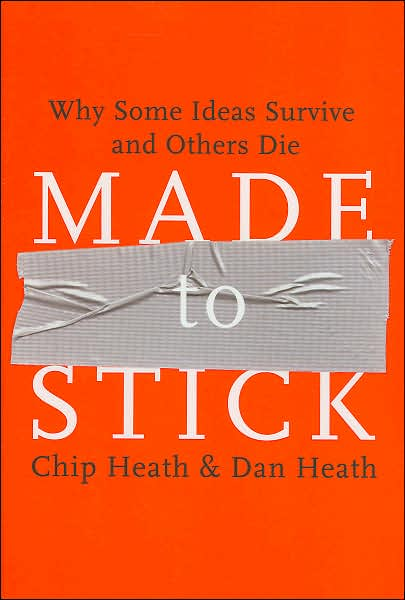I was feeling pretty overloaded yesterday - stretched at work between deadlines and training someone, having to run a game afterwards, and dealing wiht a few relationship issues. So when I finally hopped into bed and picked up 'Made to Stick' I was torn between wanting to read a bit of this book that I'd finally been able to pick up from the library, and finally going to sleep.
So, I pick it up (just to check it out) and the first thing I notice is its cover:

Immediately, I try to peel away that 'To' label ... but the library has carefully plastic-wrapped the cover. So I turn to the inside jacket, to read a bit of a description, and see that part of the book is going to be about discussing urban legends and conspiracy theories and why they spread so effortlessly. Reading through the rest of the jacket's copy, I can see that this is going to be my sort of book.
And it reminds me of this post by Seth Godin: The Purpose of a Book Cover
So I turn to the back cover, again not intending to read the book, just checking it out, and this is what I see: A list of the six qualities of 'stickiness' that the book is going to discuss together with page numbers illustrating the points. Like so:Is the purpose of the cover to sell books, to accurately describe what's in the book, or to tee up the reader so the book has maximum impact?
The third.
... Tactically, the cover sells the back cover, the back cover sells the flap and by then you've sold the book.
Simplicity: How do you strip an idea to its core without turning it into a silly sound bite? See how Army commanders force siplicity into their battle plans - page 25
Credibility: How do you get people to believe your idea? See how NBA coaches engineered an experience that made the dangers of AIDS more palpable to their players - page 162
(That AIDS example is genius, btw. If you're just interested in flicking through the book at the library, I'd recommend it.)
So I check out the examples - which are well written, entertaining and illustrative. Then I check out the table of contents which says there's an 'Easy Reference Guide' at the back of the book. That guide is a 5 page summary of the ideas in the book - which is exactly what I want most books to have, because it saves me the work of doing it myself.
By this point, I'm intrigued and entertained enough that I read the whole introduction (which you can check out here, if you're interested).
Basically, this is exactly how I'd like a non-fiction book to be designed. Easing you into the subject matter, giving you a summary of what it says right up front (rather than hiding it in the last chapter), and providing entertaining, concrete examples. I'm looking forward to reading this.
.gif)
No comments:
Post a Comment